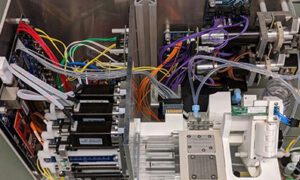In today’s digital age, having a strong online presence is essential for businesses to thrive. A well-designed and functional website plays a crucial role in attracting customers and promoting brand visibility. However, the terms “web design” and “web development” are often used interchangeably, causing confusion among those not familiar with the intricacies of the industry. While both disciplines are vital for creating a successful website, they encompass distinct skill sets and responsibilities. In this article, we will delve into the key differences between web design and web development, shedding light on their unique contributions to the website creation process.
Web Design: The Art of Visual Appeal
Web design primarily focuses on the aesthetic elements of a website. It involves creating the visual layout, user interface, and overall look and feel of a site. Web designers are responsible for crafting a visually engaging and user-friendly experience. They utilize various design principles, color schemes, typography, and imagery to capture the essence of a brand and convey its message effectively.
The process of web design typically involves several steps. It begins with gathering requirements and understanding the client’s goals and target audience. This is followed by creating a site structure and developing wireframes to outline the website’s layout and navigation. Once the wireframes are approved, web designers move on to creating mockups and prototypes using graphic design software. These visual representations give clients a clear vision of how the final website will look.
During the design phase, web designers consider factors like user experience (UX) and user interface (UI) design. UX design focuses on enhancing user satisfaction by improving the usability, accessibility, and efficiency of the website. It involves designing intuitive navigation, clear calls-to-action, and logical information architecture. On the other hand, UI design deals with the visual elements and interactive features that users directly interact with. This includes buttons, menus, sliders, and other interactive components that enhance the overall user experience.
Web Development: The Backbone of Functionality
Web development, on the other hand, is concerned with turning the web design concept into a fully functional website. Developers bring the design to life by writing code, implementing features, and ensuring smooth functionality across different devices and platforms. They are proficient in programming languages such as HTML, CSS, JavaScript, and PHP, among others.
The web development process also consists of several steps. It starts with analyzing the design and breaking it down into smaller components. Developers then begin coding the front-end using HTML, CSS, and JavaScript to create the structure, layout, and interactive elements of the website. They ensure that the website is responsive and optimized for different screen sizes and devices.
Back-end development comes next, where developers build the server-side components of the website. This involves working with databases, server configurations, and implementing the necessary logic to handle data processing, user authentication, and other server-related tasks. They use programming languages such as PHP, Python, Ruby, or Java to create dynamic web applications.
Once the development is complete, thorough testing is performed to identify and fix any bugs or issues. This includes testing the website’s functionality, responsiveness, and compatibility across various browsers and devices. After successful testing, the website is deployed to a web server and made live for users to access.
Best Practices in Web Design and Web Development
In both web design and web development, following best practices is crucial to ensure the creation of high-quality and effective websites. Here are some key best practices for each discipline:
Web Design Best Practices:
Understand the target audience: Conduct research to understand the preferences, behaviors, and needs of the target audience. Design the website to cater to their expectations and make it user-centric.
Keep it simple and intuitive: Create a clean and clutter-free design with intuitive navigation. Users should be able to find information easily
and navigate through the website effortlessly. Avoid overwhelming the user with excessive graphics or complex layouts.
Responsive design: Design the website to be responsive, ensuring it adapts seamlessly to different screen sizes and devices. This improves user experience and accessibility.
Consistency in branding: Maintain consistency in branding elements such as colors, fonts, and imagery across the website. This helps to reinforce brand identity and create a cohesive user experience.
Optimize loading speed: Optimize images, code, and other elements to ensure fast loading times. Users expect websites to load quickly, and a slow-loading site can lead to higher bounce rates.
Web Development Best Practices:
Clean and modular code: Write clean, well-structured, and maintainable code to facilitate future updates and improvements. Use modular approaches and adhere to coding standards to ensure code reusability.
Security measures: Implement security measures to protect the website and user data from vulnerabilities and cyber threats. This includes using secure protocols, regularly updating software, and incorporating user authentication and authorization mechanisms.
Search engine optimization (SEO): Optimize the website for search engines by incorporating relevant keywords, meta tags, and descriptive URLs. This helps improve the website’s visibility in search engine results and drives organic traffic.
Cross-browser compatibility: Test the website across different browsers and ensure it functions correctly on each one. This ensures a consistent user experience regardless of the browser used.
Regular backups and maintenance: Regularly back up the website’s data and perform routine maintenance tasks such as updating plugins, monitoring performance, and fixing bugs to keep the website running smoothly.
InfiniteKey: Unlocking Business Growth Through Web Solutions
When it comes to creating a successful website, businesses often seek professional assistance. InfiniteKey is a leading company that specializes in web design and web development, offering comprehensive solutions to help businesses unlock their full online potential.
With a team of skilled designers and developers, InfiniteKey understands the importance of an impactful web presence. They collaborate closely with clients to create visually stunning websites that align with their brand identity and business goals. By incorporating cutting-edge design principles and employing the latest industry trends, InfiniteKey delivers websites that captivate users and encourage engagement.
InfiniteKey’s expertise extends beyond web design and development. They offer a range of services, including search engine optimization (SEO), content creation, social media marketing, and e-commerce solutions. By providing holistic web solutions, InfiniteKey helps businesses grow their online presence, attract customers, and achieve their digital marketing objectives.
Conclusion
In conclusion, web design and web development are two essential disciplines that contribute to the creation of a successful website. While web design focuses on the visual aspects and user experience, web development brings the design to life and ensures its functionality. By understanding the distinctions between these disciplines and following best practices, businesses can create effective and visually appealing websites that drive growth and success in the online world. And with the expertise of companies like InfiniteKey, businesses can unlock their full online potential and thrive in the digital landscape.
Visit our website: Infinitekey



































